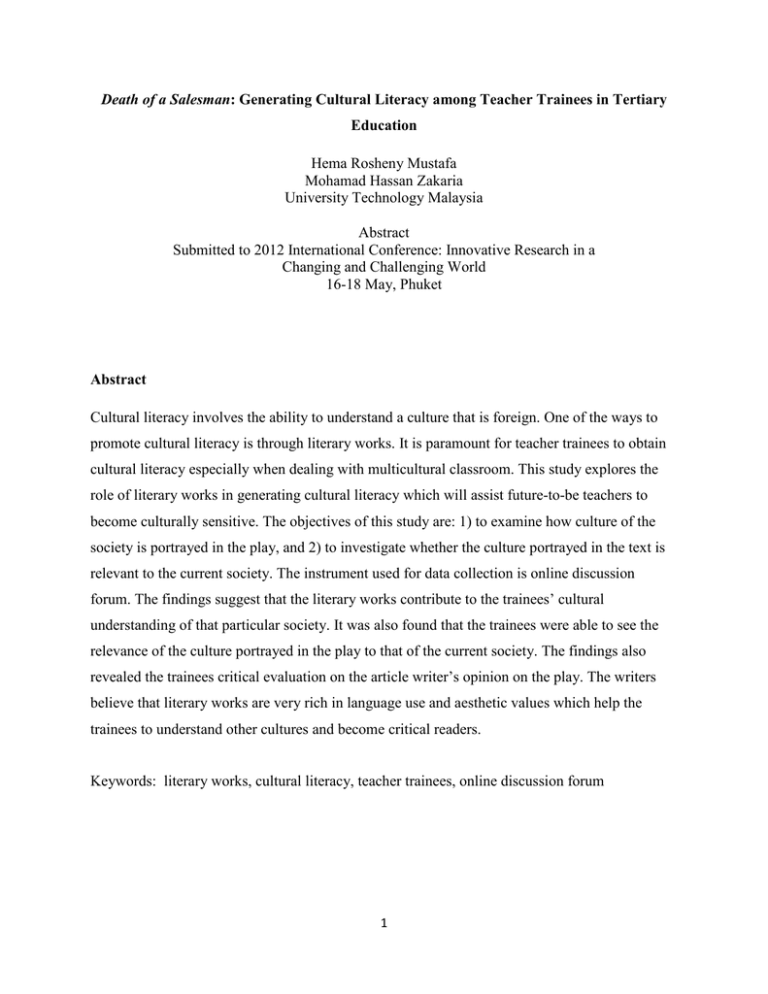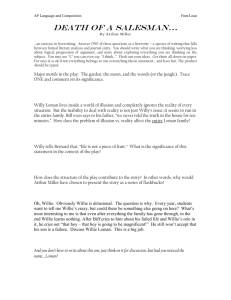Death of a Salesman Education Hema Rosheny Mustafa Mohamad Hassan Zakaria
advertisement

Death of a Salesman: Generating Cultural Literacy among Teacher Trainees in Tertiary Education Hema Rosheny Mustafa Mohamad Hassan Zakaria University Technology Malaysia Abstract Submitted to 2012 International Conference: Innovative Research in a Changing and Challenging World 16-18 May, Phuket Abstract Cultural literacy involves the ability to understand a culture that is foreign. One of the ways to promote cultural literacy is through literary works. It is paramount for teacher trainees to obtain cultural literacy especially when dealing with multicultural classroom. This study explores the role of literary works in generating cultural literacy which will assist future-to-be teachers to become culturally sensitive. The objectives of this study are: 1) to examine how culture of the society is portrayed in the play, and 2) to investigate whether the culture portrayed in the text is relevant to the current society. The instrument used for data collection is online discussion forum. The findings suggest that the literary works contribute to the trainees’ cultural understanding of that particular society. It was also found that the trainees were able to see the relevance of the culture portrayed in the play to that of the current society. The findings also revealed the trainees critical evaluation on the article writer’s opinion on the play. The writers believe that literary works are very rich in language use and aesthetic values which help the trainees to understand other cultures and become critical readers. Keywords: literary works, cultural literacy, teacher trainees, online discussion forum 1 Introduction Literary works are widely used among ESL (English as Second Language) learners. Even before the introduction of literature component in the Malaysia secondary school syllabus, literary works have been heavily utilized particularly as a Literature course in tertiary education setting. Literary works include a wide variety of genres such as poetry, short stories, plays, novels, fables and films. The aesthetic values, which are pertinent in literary works make them great teaching and learning resources in the classroom, in particular teacher trainees education. These, among other aspects of literary works (plot, setting, theme, literary devices) assist in developing literacy, predominantly cultural literacy. It is paramount for teacher trainees to obtain cultural literacy as it will help them understand the use of language to convey meanings (which can be both literally and figuratively). Previous Research on Literary Texts and Cultural Literacy A lot of researches have been carried out to investigate the use of literary works in language learning both in L1 and L2. A literature-based curriculum has been proven to function as a vehicle to enhance multicultural tolerance and competence (Collie & Slater, 1990; Langer, 1995; McKay, 1986; Wesche & Paribakht, 2000). The incorporation of literary texts in language instruction is strongly recommended for developing students’ linguistic and cultural awareness (Hadaway, Vardell & Young, 2002). Although most research adopted literary texts as the tool, it is believed that literary works in general would conjure similar findings. Literature may also serve to enhance students’ cultural competence in the target language because it represents the social context in which characters think, behave, or believe (Collie & Slater, 1990). Scott and Huntington (2000) pointed out that learning L2 culture through poetry was effective in developing affective awareness of the target culture and in reducing rigid concepts about the target culture. Viewing literature as “mirrors and windows,” Galda (1998) asserted that literature provides a window into other cultures and a reflection of readers themselves. As well as illustrating cultural information in context, literature often “challenges cultural norms, … enables the L2 readers to reflect about cultural stereotypes,” and “forces readers to rethink accepted norms” (Swaffar, 1992:245). On the other hand, there were researches who defy the above conception. A study with French literature college students by Davis (1992) revealed students’ difficulty in understanding 2 text due to lack of cultural and historical knowledge about the target culture or insufficient target language competence. It hindered students’ access to literary experience or even resulted in misunderstanding of the whole story. Thus, there is a need to fill this gap of differing views. Objectives of the study The objectives of this study are: 1) to examine how culture of the society is portrayed in the play. 2) to investigate whether the culture portrayed in the text is relevant to the current society Methodology of the Research Forum discussion was used as the method of this study. The trainees had to study the play, Death of a Salesman for 5 weeks and complete the tasks given. The tasks included classroom discussion (group work) and online forum discussion. The respondents for this study were 50 teacher trainees of Teaching English as Second Language (TESL) program. The play by Arthur Miller was chosen because it contains cultural elements which are the central point of this study. A newspaper article was also used to help the trainees in discussing the issues, in particular the second research question, which was part of the tasks. Findings and Discussions Based on the classroom discussion, the culture of the society is portrayed through: 1) the theme of the play a) Conflict among family members It is very apparent that conflict is the central theme in the play. From the beginning of the play, the readers were introduced to the conflict between the father, Willy Loman and his son, Biff. The misunderstanding started when Biff could not realize his father’s dream of making it big in business. His inability to follow his father’s 3 footstep had created tension not just to both of them but also Happy, another son and Linda, Willy’s wife. Although Linda and Willy may not seem to have any conflict, but deep reading would reveal that both were having conflict but it is more to internal conflict. Linda was always being denied to interfere especially when Willy was talking to both of his sons, Biff and Happy. He always shouted to her to shut her mouth and Linda would quietly obeyed him without any objection. However, Biff disapproved of his father’s demeanour and once he shouted at his father for ill-treating his mother. Both instances of the conflicts portrayed the culture of the American society at that time. Father-son dispute can be considered as normal as children may not see eye to eye when it involved job and future plans. b) Conflict on financial status After the Great Depression ended early 1940s, life had started picking up for the Lomans. It is obvious that Willy Loman had achieved success in his business, travelling all over America. The Chevy, refrigerator, washing machine and silk stockings were all evidences of Loman’s family financial status at that time. Willy was able to have all those ‘luxuries’ with the help from his earning as a salesman. He hoped that his two sons were able to continue his legacies but his dream was dashed. Not only his sons were not interested in business, he was laid off from work due to his old age an incapability to drive long distances. Consequently, he had made attempt to kill himself but to no avail. However, fate had its victory when Willy finally died, committing suicide while driving. This conflict portrayed the culture of that particular society as money and possessions were symbol of status. Owning things (although may not be of the best quality) was essential in order to be looked up by other people in the society. 4 2) the characters in the play a) Willy Loman Portrayed as an egoistic and snobbish salesman, the character of Willy Loman could be the reflection of other salesman of his age. He was well-known and respected when he was young but as he withered, Willy could no longer bear the responsibility as a husband and father. He could no longer provide for the family and he even had to borrow from Howard, in which he pretended that it was his wages. He could be said as snobbish as he refused to accept the job offered by Howard and refused to let go of the responsibility of providing the family to his two sons. Thus, his characteristics can be said to reflect the role of husband/father during that time. b) Linda Loman Linda was portrayed as a devoted wife to Willy who always stood beside him. Although the children detested Willy’s behaviour of hushing Linda whenever they were talking to Willy, she always defended him in return. It seems that it did not bother her at all as she kept defending Willy till the end of the play. She was portrayed to be so vulnerable that she never went against Willy’s words. Miller painted a picture of a wife figure during that time, who had to obey and oblige the husband no matter in what circumstances. c) Biff Loman Being the son of a once-successful salesman might have put a stress on Biff Loman. His life started to fall apart when he flunked math and to make matter worse, he found out about his father’s affair. Devastated, he did not finish school and started working. However, he never did succeed in his job. He was lured into Happy’s plan of borrowing money to start off a Loman’s sports business, which gave Willy a hope that his sons would follow his footstep. Eventually both of them were drawn into Willy’s American dream which later brought to a hopeless ending. Miller portrayed the culture of the American younger generation in that of Biff, who tried to relive the dream of the father, specifically and the society, in general. 5 It is quite interesting that almost all respondents were commenting on these three characters and did not mention Happy Loman. This may be due that although he is the second son, his characters are more like his father. Thus, highlighting Willy Loman can be the reflection of Happy Loman. For the second research question, the respondents were given an online newspaper article “‘Salesman’ Comes Calling, Right on Time” by Charles Isherwood, taken from New York Post dated 23 February, 2012. They were asked to decide whether they think the culture portrayed in the play is relevant to the current society and also to comment on Isherwood’s opinion in the article. 40 out of 50 respondents agreed that the play is relevant to the current society. They believed that the conflicts highlighted by Miller are relevant until today and each family would have at least one of the conflicts to deal with. They also believed that the characteristics portrayed by the Loman family and the people around them, so exist in the current society. Although time has passed, for more than sixty years since the play was written, the attitude and behaviour of people in the current society do not change. Ten of the respondents, on the other hand, claimed that the play does not reflect the culture of the current society especially the role of Linda Loman. They believed that Linda’s characteristics may not be appropriate in today’s world as most married women are now working, earning own money. Thus, they do have a say in the family matters and not easily shoved away by the shouting of the husband. Married women today are more independent and they would fight for their right instead of keeping mum, just like Linda Loman. Apart from that, when asked to comment on the article writer’s point of view, “Thanks to the explosion of social media, being “well liked” has become practically a profession in itself. Many of us are willingly to become versions of Willy Loman, forever on the road- that is online- selling ourselves and advertising our lifestyles.” (Isherwood, 2012) majority of them disagreed . Thirty of the respondents disagreed with the opinion, while seven agreed and thirteen had mixed responses. These responses, however, illustrate that the culture in the play has its relevance to today’s society. Among the negative responses given were: 6 social website is also website that provides a platform for users to express their feelings, no matter happiness or sadness. It is basically a platform for sharing things……. I strongly disagree with the opinion as the writer did not consider this issue in a big picture. Many of us are willing to advertise our lifestyle on Facebook just to share our happiness with other people but not to become versions of Willy Loman. I don’t think that most of the people tend to become a version of Willy Loman by posting a status or a picture. They are just using the convenience of technology so that they are able to keep in touch with others. Social media such as Facebook makes us more convenient to communicate with other people, not to vanquish the tormenting self-doubt like Willy Loman. In addition, Facebook updates are to let those who concern about us to know our latest condition and could not be compared with Willy Loman's characteristics. However, it is also vital to highlight those responses which agreed with the writer’s opinion. …….adults or teenagers- are trying to sell themselves through social media to claim that they are “well liked”. Society thinks that with the existence of thousands of friends on Facebook or followers on Twitter will make them confident that they are “well liked” by others. Simply put, the self-worth of a person is reflected from the way people look at them, and not as how they look at themselves. Sadly, this is a tragedy of our society which does things to satisfy others but not for self satisfaction. People evaluate you based on your status, your pictures - a proof of what you have done. These kinds of people are not enjoying the true meaning of life. They live under people's expectations and pretense. ..some people tend to upload pictures and stories to show that they are popular, like Willy, he thinks himself being well liked by others when the truth is he’s just an ordinary person. ….some of them are only trying to gain attention they lack in; maybe just like Willy Loman himself. All the 'likes' on these websites are maybe just the way they look for some attention and care due to some complications, which maybe can be related to Willy. The responses above show that respondents were able to evaluate the article writer’s opinion critically. Those who disagreed, in particular, were able to justify disparagingly by looking at social media in a positive perspective and the users are not being the version of Willy Loman. Those who agreed, on the contrary, although insignificant believed that some social media users were turning into Willy Loman, as they use it to satisfy others; friends and society in 7 general. These opinions are derived from the respondents’ experience in using the social media. They were able to relate their experience to the discussion question and this proved that they were able to look at it critically. This is also a good practice for the respondents to evaluate reading materials, read between the lines, evaluate and decide between facts or opinion and lastly to agree or disagree with the opinion. These skills are fundamental so that respondents should never always believe what they read. It can be concluded that the play has succeeded in capturing the culture of that particular society during that time. The trainees were able to identify how culture is portrayed through the theme and the characters. Miller was able to portray the characters in such a way that they reflect the society in general. In addition, the trainees were able to see the relevance of the play to today’s society although the play was written in 1949. This does not only help them to understand the culture and society during that era but also the society today. The forum discussion is a good platform for the respondents to critically voice out their views. Pedagogical Implications Gaining the understanding of culture and society can be considered as one of the component of being literate. Cultural literacy enables the teacher trainees to be effective future language teachers as: - language is a tool of learning a culture - teachers are the vehicle of imparting knowledge on culture as it is to be understood to hinder misunderstanding and being ethnocentric among students especially when dealing with foreign culture - understanding culture is utmost important especially when dealing with multicultural students - when teachers develop cultural literacy, the students should be able to develop it as well The findings have proven that literary works are great tool in generating cultural literacy due to its aesthetic values. They are also excellent to be used as discussion point among ESL 8 learners. Not only learning a new culture but at the same time, learning how to provide evidence of their interpretations, such as evaluation of the characters, story, or critical analysis of the theme. They will learn to offer textual evidence for their arguments and practiced the strategy in the discussion. Discussion forum is a comprehensive tool to be used in ESL classroom as this will give the learners, especially introvert learners who are shy to speak up in class, the chance to ‘speak’ in the online discussion. Learners who are weak in the language may also have the opportunity to prepare the answer before posting it to the online discussion forum. The supplementary material given to learners may assist their understanding of the literary work. The use of newspaper article in this study could generate the critical thinking of the learners. They are able to make connection of the article to the play that they are reading. Several studies analyzing literary responses refer to students’ connection with other texts than the one they are reading (Burke, 2000). By making the connection, learners should be able to check on their existing understanding of the play with that of the newly incoming information about characters, incidents, the novel as a whole, or the author intention. When the former understanding agreed or differed with the new information of the play, learners are to provide quotes as a counter or supporting evidence of their reinterpretation of the text. The new incoming information from the article may have triggered them to reevaluate and to shed new meaning on their previous understanding (Chu, 2008:87). Thus, it would be useful to adopt literacy as a course/subject, in particular for TESL (Teaching English as Second Language) program as it would prepare the teacher trainees to deal with multicultural classroom. It will be more constructive to include literary works as the materials in assisting cultural literacy. 9 Bibliography Burke, J. (2000). Reading reminders: Tools, tips, and techniques. Portsmouth, NH: Boynton Cook Publishers. Chu, H.H. (2008) Adult ESL Learners Reading and Discussing The Great Gatsby: Literary Response to and Perceptions of Reading and Discussing a Narrative Novel written in English. Dissertation in ProQuest. Collie, J. & Slater, S. (1990). Literature in the language classroom: A resource book of ideas and activities. Cambridge: Cambridge University Press. Davis, J. N. (1992). Reading literature in the foreign language: The comprehension/response connection. The French Review, 65(3). 359-370. Galda, L. (1998). Mirrors and windows: Reading as transformation. In T. E. Raphael & K. H. Au (Eds.), Literature-based instruction: Reshaping the curriculum (pp. 1-11). Norwood, MA: Christopher-Gordon. Hadaway, N., Vardell, S., & Young, T. (2002). Literature-based instruction with English language learners, K-12. Boston: Allyn & Bacon. Langer, J. (1995). Envisioning literature: Literary understanding and literature instruction. New York: Teachers College Press. McKay, S. (1986). Literature in the ESL classroom. In C. J. Brumfit & R. Carter (Eds.), Language and language teaching (pp. 191-198). Oxford: Oxford University Press. Scott, V. M., & Huntington, J. A. (2000). Reading culture: Using literature to develop C2 competence. Foreign Language Annuals, 35(6), 622-631. Swaffar, J. K. (1992). Written texts and cultural meanings. In C. Kramsch & S. McConnell-Ginet (Eds.), Tex and context: cross-cultural perspectives on language study (pp. 238-250). Lexington, MA: D. C. Heath. Wesche, M. B., & Paribakht, T. S. (2000). Reading-based exercises in second language vocabulary learning: An introspective study. The Modern Language Journal, 84(2), 196-213. 10





